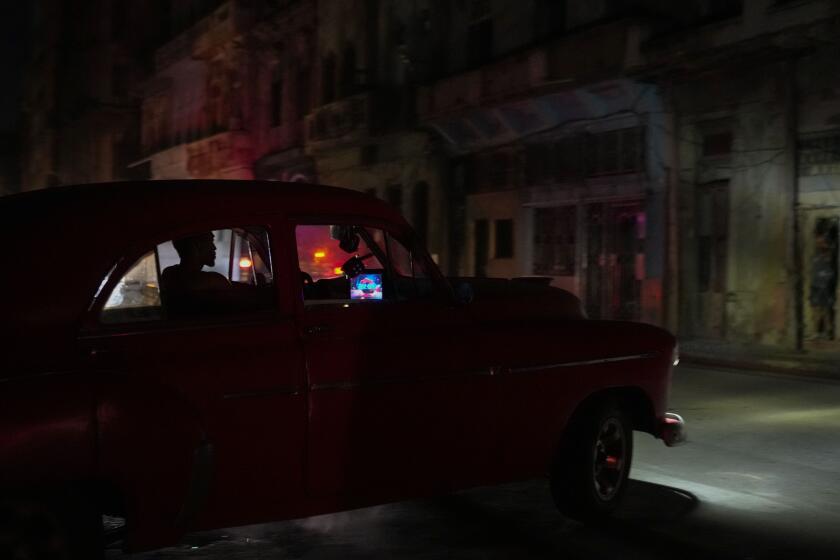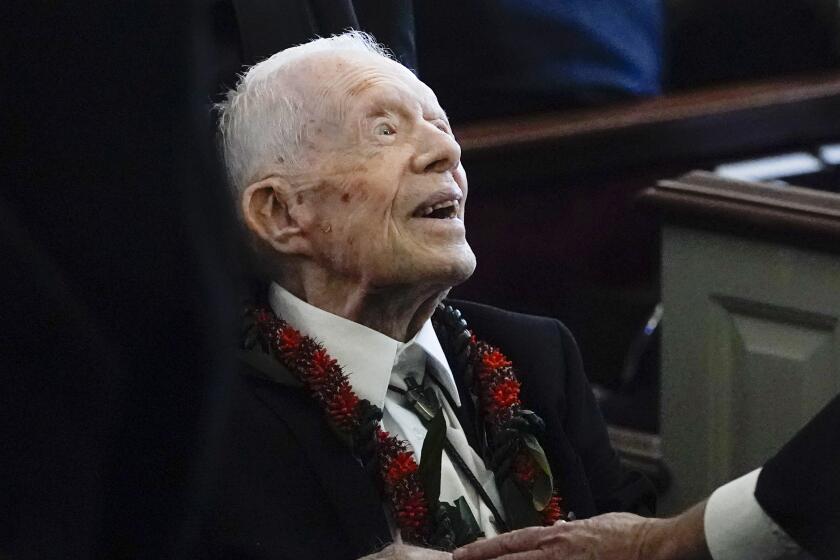Pilgrimage to N. Mexico Site Stands as Testament to Faith : Religion: A dirt pit draws thousands who seek miracle cures. Skeptics abound, but many say they miss the point.
Casey Stevens made his annual pilgrimage Friday to a humble adobe sanctuary, its walls lined with candles, statues of saints and castaway crutches.
As he emerged beneath the low doorway, he winced, as much from the pain that forced him to lean heavily on a cane as from the brilliance of the sun. The fingernails of his sunburned hands were encrusted with remnants of earth he had scooped from a small pit inside El Santuario de Chimayo, known far and wide for the curative powers of its soil.
It was the 30th time Stevens had made this trek on Good Friday, and this year he was among more than 12,000 Easter faithful marching in the hot, dry wind in the hills of northern New Mexico in what has become the largest ritual pilgrimage in the United States. By Sunday, church officials expect more than 60,000 to have entered the dark, cool recesses of the sanctuary during Easter week.
Old and young, they came on foot, on horseback, in wheelchairs and on crutches. Some toted rustic wooden crosses. Others tooled in ground-hugging cars custom painted with visages of Jesus and Our Lady of Guadalupe. All were drawn by stories of miraculous cures.
Some walked from Santa Fe, 30 miles away, or from Albuquerque, a 90-mile-hike. At 76, Stevens could manage only 12 miles through the undulating foothills of the snow-capped Sangre de Cristo Mountains. Though he stinted on distance, he showed his devotion by leaving his back brace at home.
“I hurt like a son of a gun,” said the Los Alamos, N.M., man, who was wounded during the Japanese attack on Pearl Harbor. “But it’s my penance.”
Many of the Chimayo pilgrims, like Stevens, are believers. Others, curious about the church’s legend, come to see a rite unique to the Southwest. Yet officials for the Roman Catholic Church see the growing popularity of the event as testament to a renewal of faith under way as the century winds to a close.
“Technology is the answer for communication and travel, but not for our emotional and spiritual needs,” said Father Miguel Mageo, who came to the wooden and adobe chapel as pastor four years ago.
“The human hand can do many wonderful things,” Mageo said. “But the human heart is forever the same and needs understanding, love and compassion.”
There are doubters who decry what they see as the increasingly carnival atmosphere, and the commercial emphasis on sales of carved saints, known as santos, and other religious tokens. There is, they say, no mystic powers to the dirt in the 14-inch diameter pit, which is replenished often from a mound of dirt behind the sanctuary.
But while the Catholic church does not officially proclaim that miracles occur at the site, Catholic leaders say skeptics miss the point.
“The church is not trying to pull the wool over anyone’s eyes,” said Father Thomas Steele, a Jesuit priest and historian of Southwestern religious culture. “Everyone knows the hole is filled with sand taken from the river. It’s not the earth that performs miracles, it is faith.”
Pilgrims have been coming to Chimayo since the modest sanctuary was finished in 1816 as an offering of thanks by Don Bernardo Abeyta, who, legend has it, discovered a crucifix at the site near the Santa Cruz River.
That crucifix of a dark-skinned Jesus now stands on the altar of the chapel that was declared a National Historic Landmark in 1970.
But even before the Spaniards arrived, this wooded glen was a gathering place for generations of the region’s Pueblo Indians who sought the restorative powers of a now dried-up mud springs.
“The holiness of the place is pre-Christian,” said Steele. “The Spaniards brought it into the orbit of Christendom.”
As word spread beyond the valley, the mostly Latino faithful began coming from greater and greater distances. Still, the penitents numbered only a thousand or so for most of this century. Then, as more and more people began talking of their pilgrimage, and wondrous cures, “something special began to happen,” Mageo said.
In the last decade, it has become an annual rite of spring, attracting tourists from around the world. It remains a Latin-flavored spectacle, with pilgrims reciting the rosary as they walk and troubadours singing Catholic hymns in Spanish. And the low-riders cruising the several roads leading to the village blare with the sounds of popular Mexican songs.
“Years ago, Anglos thought we were weird,” said Mary Louise Giron, 50, of Santa Fe, who was linked arm-in-arm with her mother and her son. “We’re finally being recognized and accepted for who we are, what we mean and stand for: faith, unity, respect and love.”
It is also a time for locals to congregate and show off their artistic endeavors, as well as to sell the ubiquitous religious curios and the ever present ristras, or strings, of hot New Mexican red chilis.
Arthur Medina, 32, was hanging ristras on nails in the adobe walls of his roadside stand, which was marked by the sign: “Holy Chilis.” He kept a close eye on a 1976 Cadillac low-rider he had emblazoned with airbrushed images of Jesus’ Stations of the Cross.
“I call them ‘holy chilis’ because I sprinkle them with the holy dirt before I sell them,” he said. “I call the car ‘low-rider heaven.’ ”
A few yards away, Ginger Burns, a 71-year-old Baptist from Duncan, Okla., joined the line of people who had waited as long as three hours to get inside the cramped incense-laden sanctuary. Last year, Burns got some of Chimayo’s dirt for her daughter who suffers from a degenerative disease of the nervous system.
Her daughter is not cured, but Burns believes her pilgrimage helped her find a doctor to treat the condition. She returned this year to give thanks.
For the skeptics, Stevens, the veteran of Pearl Harbor, said belief in Chimayo is a measure of one’s faith.
“I know people who think it’s a joke, but for me it’s part of my religion and who I am,” he said, surveying the multitudes thronging the gravel paths to the chapel.
“I hope they find what they are looking for,” he said.
More to Read
Sign up for Essential California
The most important California stories and recommendations in your inbox every morning.
You may occasionally receive promotional content from the Los Angeles Times.











